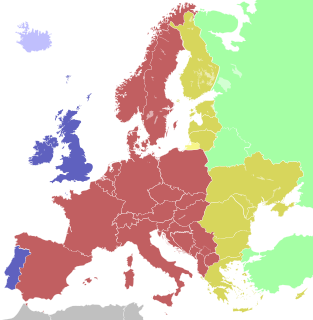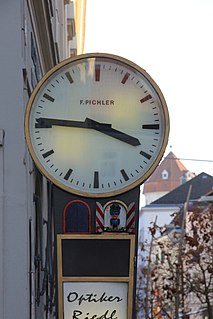Related Research Articles

The time zone in Germany is Central European Time and Central European Summer Time. Daylight saving time is observed from the last Sunday in March to the last Sunday in October. The doubled hour during the switch back to standard time is named 2A and 2B.

Time in the Czech Republic is given by Central European Time and Central European Summer Time. Daylight saving time is observed from the last Sunday in March to the last Sunday in October. The Czech Republic has observed Central European Time since 1979. Until 1993 when Czechoslovakia was separated into the Czech Republic and Slovakia, they also had Central European Time and Central European Summer Time. After the summer months, time in the Czech Republic is shifted back by one hour to Central European Time. Like most states in Europe, Summer time is observed in the Czech Republic, when time is shifted forward by one hour, two hours ahead of Greenwich Mean Time.
Switzerland uses a single time zone, denoted as Central European Time. Switzerland also observes summer time, shifting to Central European Summer Time.
In Sweden, the standard time is Central European Time. Daylight saving time is observed from the last Sunday in March to the last Sunday in October. Sweden adopted CET in 1900.

In Austria, the standard time is Central European Time. Daylight saving time is observed from the last Sunday in March to the last Sunday in October.

In Albania, the standard time is Central European Time. Daylight saving time, which moves one hour ahead to Central European Summer Time, is observed from the last Sunday in March to the last Sunday in October. Albania adopted CET in 1914.
In Serbia, the standard time is Central European Time. Daylight saving time is observed from the last Sunday in March to the last Sunday in October. Serbia adopted CET in 1884.
In Montenegro, the standard time is Central European Time. Daylight saving time is observed from the last Sunday in March to the last Sunday in October. Montenegro has consistently used CET since it gained independence in 2006.
In Andorra, the standard time is Central European Time. Daylight saving time is observed from the last Sunday in March to the last Sunday in October. Andorra adopted CET after WWII.

In Greece, the standard time is Eastern European Time. Daylight saving time, which moves one hour ahead to UTC+03:00 is observed from the last Sunday in March to the last Sunday in October. Greece adopted EET in 1916.

Time in Poland is given by Central European Time. Daylight saving time, which moves an hour ahead, is observed from the last Sunday in March to the last Sunday in October. This is shared with several other EU member states.
In Slovenia, the standard time is Central European Time. Daylight saving time is observed from the last Sunday in March to the last Sunday in October. This is shared with several other EU member states.
In North Macedonia, the standard time is Central European Time. Daylight saving time is observed from the last Sunday in March to the last Sunday in October. This is shared with several other EU member states.
In San Marino, the standard time is Central European Time. Daylight saving time is observed from the last Sunday in March to the last Sunday in October. This is shared with several other EU member states.
In Monaco, the standard time is Central European Time. Daylight saving time is observed from the last Sunday in March to the last Sunday in October. This is shared with several other EU member states.

In Bulgaria, the standard time is Eastern European Time. Daylight saving time, which moves one hour ahead to UTC+03:00 is observed from the last Sunday in March to the last Sunday in October, inline with most EU member states.

In Romania, the standard time is Eastern European Time. Daylight saving time, which moves one hour ahead to UTC+03:00 is observed from the last Sunday in March to the last Sunday in October.

Time in Lithuania is given by Eastern European Time. Daylight saving time, which moves one hour ahead to UTC+03:00 is observed from the last Sunday in March to the last Sunday in October. Latvia adopted EET in 1920.
In Luxembourg, the standard time is Central European Time. Daylight saving time is observed from the last Sunday in March to the last Sunday in October.
In Kosovo, a partially recognised state in Southeastern Europe, the standard time is Central European Time. Daylight saving time, which is one hour ahead, is observed from the last Sunday in March to the last Sunday in October.
References
- ↑ Time in Croatia. TimeAndDate.com. Retrieved 2 May 2021.
- ↑ Croatia at The World Factbook . Central Intelligence Agency (CIA). Retrieved 2 May 2021.
- ↑ "8.19.2. Znak za odjeljivanje sati i minuta - Hrvatski pravopis". Pravopis.hr (in Croatian). Retrieved 2 May 2021.
- ↑ Europe (2020 edition) at the tz database. Internet Assigned Numbers Authority (IANA). Retrieved 20 May 2021.